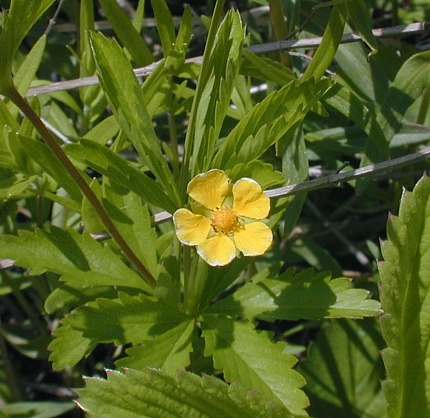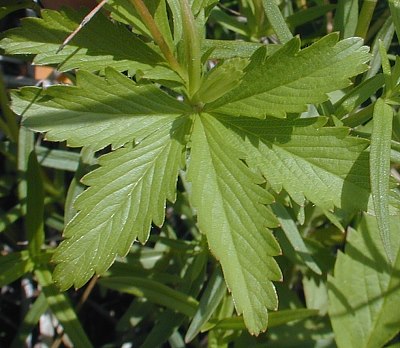Description: This perennial plant sprawls along the ground by means of stolons; it is less than 1' tall. The slender stems and stolons are initially green, but become red with age. Depending on the local ecotype, they can be nearly glabrous, or covered with spreading white hairs. The stolons can extend up to 3' and their tips often root in the ground, forming new plantlets. The compound leaves are palmate (with 5 leaflets) and alternate along the stolons or stems. Each leaflet is up to 3" long and ¾" across. There is coarse serration along the margins, except near the base, and prominent venation. The upper surface is glabrous, while the lower surface may be hairy or nearly glabrous. The leaflets are narrowly ovate (but with blunt tips), obovate, or oblanceolate; young leaflets often have their margins curled upward. A single yellow flower develops from a long pedicel from the upper axils of some of the compound leaves. This flower is about ½" across, and has 5 yellow petals that are narrow at the base, but rounded toward their tips, which are sometimes notched. The green calyx has 5 triangular tips that are a little shorter than the petals. The center of the flower has a somewhat flattened reproductive structure, which is surrounded by about 20 stamens. The blooming period can occur from spring to mid-summer, and lasts about a month. Only a few flowers are in bloom at the same time. There is no noticeable floral scent. The achenes are without tufts of hair. There is a short, thick rootstock that divides into coarse secondary roots. This plant often forms loose colonies by means of its stolons.

Cultivation:
The
preference is partial to full sun, and moist to dry conditions. The
soil can consist of loam, clay-loam, or contain gravelly material. This
is an easy plant to grow that presents few problems.
Range & Habitat:
The native Common Cinquefoil occurs in every county of Illinois and it
is fairly
common (see Distribution
Map). Habitats include mesic to dry black soil prairies, open
upland forests, savannas, gravelly seeps, and abandoned fields. This
plant occurs in both disturbed areas and high quality habitats. In
tallgrass prairies, it is one of the understory plants.
Faunal Associations:
The flowers primarily attract small bees and flies, including Mason
bees, Small Carpenter bees, Nomadine Cuckoo bees, Halictid bees,
Syrphid flies, Tachinid flies, Blow flies, and others. Less common
visitors are wasps, skippers, and butterflies. These insects seek
nectar, although bees also collect pollen. The seeds are little used by
birds. Small mammalian herbivores, such as rabbits and groundhogs,
often eat the foliage. It is possible that some of the seeds of Common
Cinquefoil can pass through their digestive tracts unharmed, and are
thus distributed by them; some studies involving livestock have found
this to be the case with a similar species, Potentilla recta
(Sulfur Cinquefoil).

Photographic
Location:
The above photographs were taken at Loda Cemetery Prairie in Iroquois
County, Illinois.
Comments:
This is another plant that fits the stereotype of a weed, but it also
occurs in prairies and other native habitats. The flowers are
reasonably showy during the spring, but few in number. Common
Cinquefoil resembles many other species of Cinquefoil, both native and
introduced. Its compound leaves almost always have 5 leaflets, the
flowers are bright yellow, and it sprawls along the ground; other
species often have a fewer or greater number of leaflets, their flowers
may be white or pale yellow, or they are erect. Common Cinquefoil is
perhaps most similar to the native Potentilla canadensis
(Dwarf Cinquefoil), except that the latter is a smaller plant with
blunter leaftlets that are strongly obovate or oblanceolate.